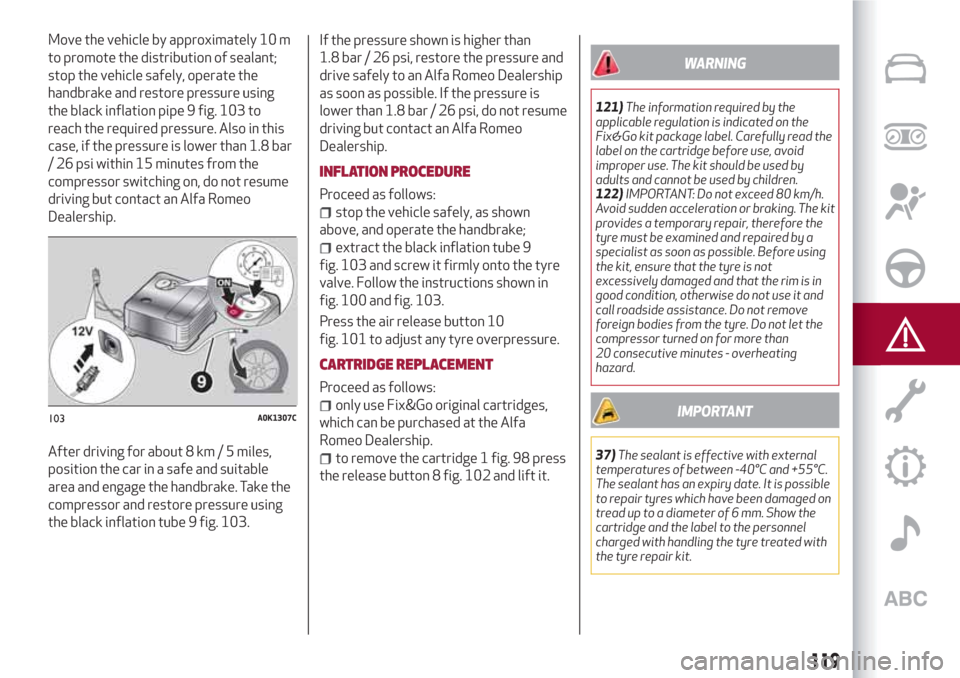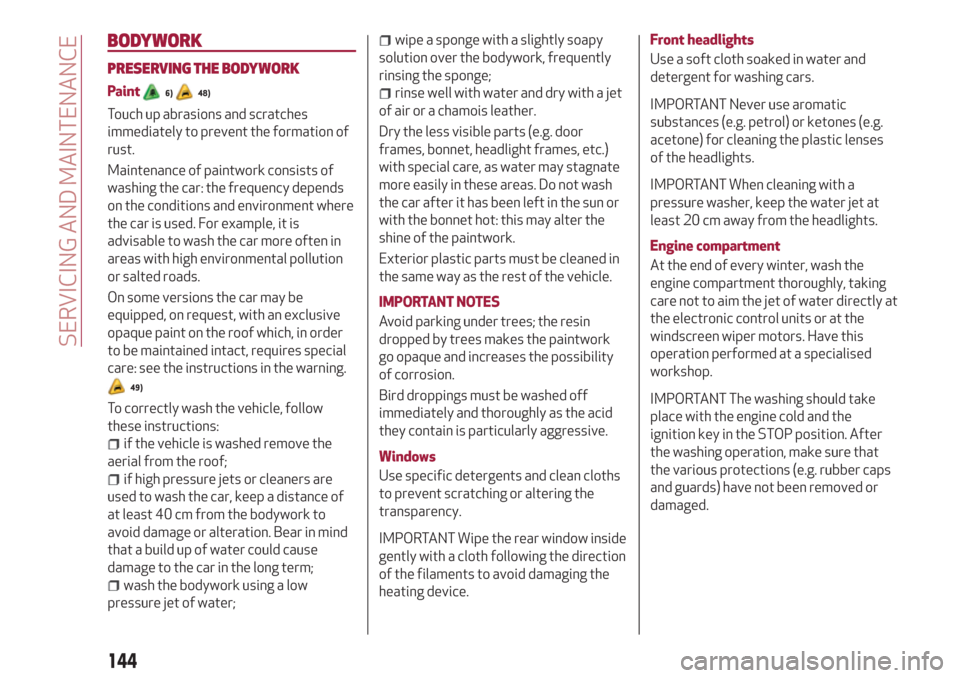2018 Alfa Romeo Giulietta heating
[x] Cancel search: heatingPage 86 of 216

STARTING THE ENGINE
Before starting the engine, adjust the
seat, the interior rear view mirrors, the
door mirrors and fasten the seat belt
correctly.
Never press the accelerator pedal for
starting the engine.
If necessary, messages indicating the
starting procedure can be shown on the
display.
ENGINE STARTING PROCEDURE
90) 91) 92)
21) 22) 23)
Proceed as follows:
engage the handbrake and place the
gear lever in neutral;
turn the ignition key to the MAR-ON
position. ONLY FOR DIESEL VERSIONS:
The instrument panel
warning light
comes on and the
icon appears on
the display.
wait for the warning lights to switch
off;
fully depress the clutch pedal, without
touching the accelerator;
turn the ignition key to AVV and
release it as soon as the engine starts.
If, with the ignition key turned to MAR,
the icon
on the display stays on
together with the warning light
, turn
the key to STOP and then back to MAR. If
the icon continues to stay on, try with the
other keys provided with the car. Contact
an Alfa Romeo Dealership if the engine
still does not start.
Never leave the ignition key in
MAR-ON position when the engine is
stopped.
ENGINE MINIMUM OIL LEVEL
INDICATION
(where provided)
When the ignition key is turned to MAR
the display shows a warning message, for
a few seconds, if the engine oil is at the
minimum level.
IMPORTANT To perform the engine oil
reading correctly, after turning the
ignition key to MAR wait for about
2 seconds before starting the engine.
WARNING
90)It is dangerous to run the engine in
enclosed areas. The engine takes in oxygen
and releases carbon dioxide, carbon
monoxide and other toxic gases.
91)The brake servo is not active until the
engine is started, so you would need to apply
much more force than usual to the brake
pedal.92)Do not start the engine by pushing,
towing or driving downhill. These
manoeuvres may damage the catalytic
converter.
IMPORTANT
21)We recommend that during the initial
period, or during the first 1600 km
(1000 miles), you do not drive to full car
performance (e.g. excessive acceleration,
long journeys at top speed, sharp braking,
etc.).
22)When the engine is switched off never
leave the ignition device in the MAR position
to prevent useless current absorption from
draining the battery.
23)A quick burst on the accelerator before
turning off the engine serves absolutely no
practical purpose; it wastes fuel and is
damaging for the engine.
24)Warning light
will flash after starting
or during prolonged cranking to indicate a
fault with the glow plug heating system. If
the engine starts, the vehicle can be regularly
used, but an Alfa Romeo Dealership must be
contacted as soon as possible.
84
STARTING AND DRIVING
Page 115 of 216

Luggage compartment fuse boxfig. 89
DEVICE PROTECTEDFUSE AMPERE
Left front seat movementF1 15
Right front
seat movementF2 15
Electric sunroofF3 15
Front seat heatingF5 15
BOSE amplifier + SubwooferF6 20
IMPORTANT
33)Never replace a fuse with metal wires or anything else.
34)If it is necessary to wash the engine compartment, take care not to directly hit the fuse box and the window wiper motors with the water jet.
WARNING
110)If a fuse blows again, contact an Alfa Romeo Dealership.
111)Never replace a fuse with another with a higher amp rating; DANGER OF FIRE.
112)If a general protective fuse (MAXI-FUSE, MEGA-FUSE, MIDI-FUSE) blows, contact an Alfa Romeo Dealership.
113)Before replacing a fuse, make sure that the ignition device is at STOP, that the key, if mechanical, has been removed and that all devices are
switched off and/or disconnected.
114)Contact an Alfa Romeo Dealership if a safety system (airbags, brakes), transmission system (engine, gearbox) or steering system general
protection fuse blows.
113
Page 121 of 216

Move the vehicle by approximately 10 m
to promote the distribution of sealant;
stop the vehicle safely, operate the
handbrake and restore pressure using
the black inflation pipe 9 fig. 103 to
reach the required pressure. Also in this
case, if the pressure is lower than 1.8 bar
/ 26 psi within 15 minutes from the
compressor switching on, do not resume
driving but contact an Alfa Romeo
Dealership.
After driving for about 8 km / 5 miles,
position the car in a safe and suitable
area and engage the handbrake. Take the
compressor and restore pressure using
the black inflation tube 9 fig. 103.If the pressure shown is higher than
1.8 bar / 26 psi, restore the pressure and
drive safely to an Alfa Romeo Dealership
as soon as possible. If the pressure is
lower than 1.8 bar / 26 psi, do not resume
driving but contact an Alfa Romeo
Dealership.
INFLATION PROCEDURE
Proceed as follows:
stop the vehicle safely, as shown
above, and operate the handbrake;
extract the black inflation tube 9
fig. 103 and screw it firmly onto the tyre
valve. Follow the instructions shown in
fig. 100 and fig. 103.
Press the air release button 10
fig. 101 to adjust any tyre overpressure.
CARTRIDGE REPLACEMENT
Proceed as follows:
only use Fix&Go original cartridges,
which can be purchased at the Alfa
Romeo Dealership.
to remove the cartridge 1 fig. 98 press
the release button 8 fig. 102 and lift it.
WARNING
121)The information required by the
applicable regulation is indicated on the
Fix&Go kit package label. Carefully read the
label on the cartridge before use, avoid
improper use. The kit should be used by
adults and cannot be used by children.
122)IMPORTANT: Do not exceed 80 km/h.
Avoid sudden acceleration or braking. The kit
provides a temporary repair, therefore the
tyre must be examined and repaired by a
specialist as soon as possible. Before using
the kit, ensure that the tyre is not
excessively damaged and that the rim is in
good condition, otherwise do not use it and
call roadside assistance. Do not remove
foreign bodies from the tyre. Do not let the
compressor turned on for more than
20 consecutive minutes - overheating
hazard.
IMPORTANT
37)The sealant is effective with external
temperatures of between -40°C and +55°C.
The sealant has an expiry date. It is possible
to repair tyres which have been damaged on
tread up to a diameter of 6 mm. Show the
cartridge and the label to the personnel
charged with handling the tyre treated with
the tyre repair kit.
103A0K1307C
119
Page 146 of 216

BODYWORK
PRESERVING THE BODYWORK
Paint6)48)
Touch up abrasions and scratches
immediately to prevent the formation of
rust.
Maintenance of paintwork consists of
washing the car: the frequency depends
on the conditions and environment where
the car is used. For example, it is
advisable to wash the car more often in
areas with high environmental pollution
or salted roads.
On some versions the car may be
equipped, on request, with an exclusive
opaque paint on the roof which, in order
to be maintained intact, requires special
care: see the instructions in the warning.
49)
To correctly wash the vehicle, follow
these instructions:
if the vehicle is washed remove the
aerial from the roof;
if high pressure jets or cleaners are
used to wash the car, keep a distance of
at least 40 cm from the bodywork to
avoid damage or alteration. Bear in mind
that a build up of water could cause
damage to the car in the long term;
wash the bodywork using a low
pressure jet of water;
wipe a sponge with a slightly soapy
solution over the bodywork, frequently
rinsing the sponge;
rinse well with water and dry with a jet
of air or a chamois leather.
Dry the less visible parts (e.g. door
frames, bonnet, headlight frames, etc.)
with special care, as water may stagnate
more easily in these areas. Do not wash
the car after it has been left in the sun or
with the bonnet hot: this may alter the
shine of the paintwork.
Exterior plastic parts must be cleaned in
the same way as the rest of the vehicle.
IMPORTANT NOTES
Avoid parking under trees; the resin
dropped by trees makes the paintwork
go opaque and increases the possibility
of corrosion.
Bird droppings must be washed off
immediately and thoroughly as the acid
they contain is particularly aggressive.
Windows
Use specific detergents and clean cloths
to prevent scratching or altering the
transparency.
IMPORTANT Wipe the rear window inside
gently with a cloth following the direction
of the filaments to avoid damaging the
heating device.
Front headlights
Use a soft cloth soaked in water and
detergent for washing cars.
IMPORTANT Never use aromatic
substances (e.g. petrol) or ketones (e.g.
acetone) for cleaning the plastic lenses
of the headlights.
IMPORTANT When cleaning with a
pressure washer, keep the water jet at
least 20 cm away from the headlights.
Engine compartment
At the end of every winter, wash the
engine compartment thoroughly, taking
care not to aim the jet of water directly at
the electronic control units or at the
windscreen wiper motors. Have this
operation performed at a specialised
workshop.
IMPORTANT The washing should take
place with the engine cold and the
ignition key in the STOP position. After
the washing operation, make sure that
the various protections (e.g. rubber caps
and guards) have not been removed or
damaged.
144
SERVICING AND MAINTENANCE